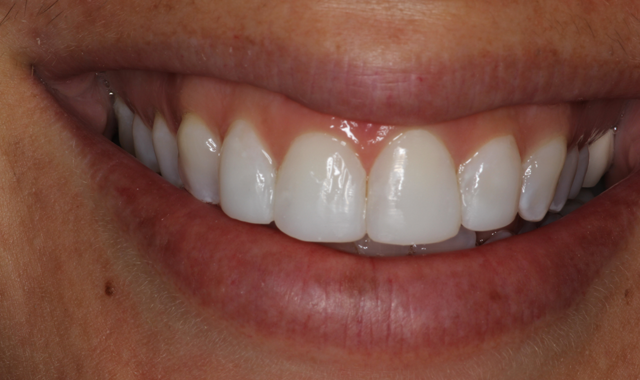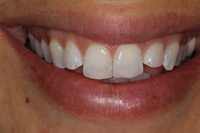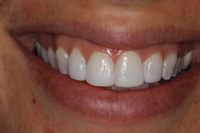Why I fired my dental lab and hired ProVeneer for my veneers
I started practicing dentistry in 1975 just about the time that light curing of restorations was being introduced.

I started practicing dentistry in 1975 just about the time that light curing of restorations was being introduced.
Before that time, all restorative materials were self cured, making it a longer and more cumbersome procedure. So I purchased one of the original UV light curing units when it first became available, and, early on in my career, became a proponent of cosmetic dentistry.
Related reading: The search for the best veneer system
I started by doing light cured anterior composites and then progressed to posterior composites. As I got more proficient, I began doing full-facial composite veneers. These did pretty well but were very time-consuming due to inherent porosities in the composite materials. They also stained and required a high level of maintenance and repairs.
So when porcelain veneers came into the spotlight, I thought I had found nirvana. These provided beautiful, long-lasting restorations. Initially, when I started with porcelain veneers, it was a minimal prep technique using feldspathic porcelain. These were truly gorgeous but not as strong as the current e.max-type materials available today. So there was an occasional breakage or chipping, which required removingl of the veneer, reimpressioning, temporizing and having the lab try to match the original veneers. This, at times, proved very challenging, and sometimes the new veneer had to be sent back to the lab one or more times until it was a close to perfect match.
More on cosmetic dentistry: The latest and greatest trends in cosmetic dentistry
Continue reading on Page 2 ...
Fast forward to the present and the challenges many dentists face today. Because of the economy the past five years, patients have not been as accepting of high fee cosmetic dentistry cases as they were in the past. There is much more competition as dental schools have graduated many students with huge debt services. Many of these dentists provide cosmetic services at greatly reduced fees so people price shop, and fees for cosmetic dentistry have either stabilized or come down. At the same time, dental overhead is a monster as dental supplies and dental lab fees are a major portion of a practice’s overhead.
To be able to provide an excellent cosmetic service to patients, the dentist must have a dental laboratory that can provide consistent, excellent work. These types of labs are few and far between. Oftentimes, a lab will give you its best technician, and you will feel you have found the right lab. Then it will slip back into its old habits once it has gained you as a customer. The really great lab technicians and labs have priced themselves above the affordability of most dentists that have traditional dental practices and charge reasonable fees to their patients.
My practice has a mix of patients with some fee-for-service and some enrolled in PPO insurance programs. I have used all types of labs over the years from the most expensive (sometimes up to $500 per unit for veneers) to large laboratories that deal in huge volume and are able to provide very affordable fees (less than $100 per unit for crowns or veneers). Regardless of the laboratory, I still have the stress of seating a single or large veneer case and being able to deliver it the first time with no remakes due to problems with color shading, anatomy, contours, contacts, bulkiness or overall appearance of the case.
More on cosmetic dentistry: 6 strategies to grow your practice's production in cosmetic dentistry
Continue reading on Page 3 ...
Smile makeover and veneer cases are very demanding and exacting to get them just right. You must present the case and gain patient acceptance. Then you must plan the case with diagnostic wax-ups, direct mock-ups and/or computer imaging. All of these are time-consuming and add expense to the process, but they are an essential part of the road map to being able to deliver high end cosmetic dentistry. You also need a your long appointment to prepare the veneers, take impressions and fabricate provisionals. This is not a walk in the park for the patient or the dentist no matter how great the dentist’s abilities are.
The provisional veneers should mimic the final veneers very closely and are an excellent guide for the lab in fabricating the final restorations. If the patient is happy with his or her provisional veneers, this will all but assure your final success and patient acceptance.
Ebook: The top new trends in cosmetic dentistry
Sometimes the patient will leave with what you thought were ideal provisionals and request a change after living with them for a few days or a week. Then you need to have them back to do an adjustment and take study model impressions of the adjusted provisionals and new photographs for the laboratory. This is an additional visit and additional chairtime you are not paid for (unless you build into your pricing structure). There are also additional visits if a provisional veneers chips, breaks or comes off and needs to be replaced.
Now you have reached the stage where you are ready to deliver the veneers. You have a one- or two-hour appointment scheduled for delivery and are confident everything will go smoothly and the case will be delivered and completed. You remove the provisional veneers and try on the permanent veneers. If you are really fortunate, the veneers fit perfectly with no adjustments necessary. You bond them in and have a very happy and satisfied patient. But what is the reality of this happening with every case?
More on cosmetic dentistry: 6 strategies to grow your practice's production in cosmetic dentistry
Continue reading on Page 4 ...
For me, unfortunately it is not the norm. I find often I need to adjust the contacts to get the entire case to seat perfectly. This can be time-consuming, depending on the amount of adjustment required. Other times, we try in the case, and the shade is not acceptable. The lab did not follow your prescription precisely, and their quality control did not catch the fact that it does not match the shade guide you specified. This means replacing or remaking the temporaries, a return of the case to the lab and an additional visit for the patient with additional unpaid time for the dentist.
So how do we make a living doing this? We have been put on a treadmill between having to provide excellent services for affordable fees, running a profitable dental business while keeping our customers happy and satisfied and keeping our staff motivated and happy.
More on patient acceptance: 3 ways to get your patients to say "yes"
Is there a better way? Yes, according to Dr. Harvey Silverman. I met Dr. Silverman through an article in Dental Products Report describing how to increase the amount of cosmetic dentistry accepted by your patients. It is based on his cosmetic dentistry consulting and marketing program that trains you and your staff how to open dialogues with patients and finding out what they want and not necessarily what they need.
One of the key components of the system is ProVeneer’s Smile Preview Veneer (Silmet Ltd.). This patent-pending preview veneer allows you to custom-make a veneer from scratch in two minutes or less (it is not a preformed veneer) so patients can see the result before they make a decision to move forward with treatment. This also gives the dentist the chance to see if the patient is a candidate for this treatment (if one or several veneers are necessary to solve his or her problem and if it can be done without tooth preparation while blending in with the adjacent natural teeth) without spending excessive time or money (wax-ups, computer imaging, etc.)
Related reading: 5 ways to boost the whitening portion of your practice
Continue reading on Page 5 ...
I found that by using this approach, we do not sell cosmetic dentistry to patients (which I would not do). We find out what they want and then show them how it will look and let them experience the process. Patients love this, and case acceptance is fantastic.
Now for the best part. When it comes time to do the actual treatment, using the ProVeneer RBFM (resin-based foundation material), fabricating a chairside veneer is extremely easy. The material is so easy to use that the entire procedure, from start to finish for one veneer, takes about 15 minutes on average. As a dentist, I appreciate the fact that I have total control over the color and shape. I am only limited by my imagination and creativity.
Related reading: Cosmetic dentists to the stars
Placement and finishing is a snap, and when completed and we give the patient a mirror to see the result, 80 to 90 percent of the time, they will say, “wow." I have never had this reaction on such a consistent basis for any dentistry I have done in my 40-year dental career.
With ProVeneer, I eliminated lab fees, provisional restorations, preparing teeth and taking impressions, cost of impression material and bite registration material and the cost and time for a CEREC veneer (in which you must calculate cost of the CEREC investment plus cost of materials, maintenance and cost of annual support). This is not $20-$25 per unit as they might lead you to believe. CEREC is a great option, but, in my opinion, ProVeneer has it beat by a mile.
From Dr. Silverman: 5 steps to increase cosmetic dentistry awareness among patients
Continue reading on Page 6 ...
It is very important to me that I have eliminated frustrations with dealing with dental laboratories' inconsistencies that have caused cases to take longer for me and my patients. My staff and I are no longer stressed as we have much more relaxed patients.
So why aren’t more dentists doing ProVeneer? Because it is the best-kept secret in cosmetic dentistry today. But ProVeneer is a better way to provide cosmetic services to patients in a noninvasive way, which 95 percent or more of your patients would prefer, if you survey them.
Whiter and brighter: The exciting evolution of cosmetic dentistry
Using the Silverman Institute of Cosmetic Dentistry's practice management system, in about 30 minutes a day, you can do an additional $50,000-$250,000 in cosmetic dentistry. If you would be interested in duplicating my experience and looking at a way to provide cosmetic services to your patients in the least invasive way, please feel free to contact me at GB@easysmiledentistry.com.
In closing this article, I want to again offer my most sincere thanks to ProVeneer for this amazing product and to Dr. Silverman for his fantastic consulting and marketing program and his time with my staff and I in helping us implement this service into our practice.
Related reading: 4 ways to enhance cosmetic dentistry opportunities
Continue reading on Page 7 ...
I realize steadily increased monthly revenues and net profits, as well as an increase in the value of my practices and less stress and more free time. My patients and staff are happy, and so am I. I am 65 years old and I now have a renewed passion in dentistry. I feel like I can practice forever, if I so desire!
Watch a video of a pleased ProVeneer customer below:
Before

After

How-to technique: How to cooperatively fix a failed cosmetic case
Todd Snyder Builds New Dental Teaching Facility in Las Vegas
July 1st 2024Infinix, equipped with the latest technology and offering both in-person lectures and over the shoulder learning as well as interactive live online and recorded learning opportunities, looks to deliver a new way of dental education.